Palazzo Bovara’s History
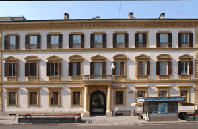
The flagship location and an object of particular attention from the Union of Trade, Tourism, Services and Professions of the Province of Milan (in Italian, l'Unione del Commercio, del Turismo, dei Servizi e delle Professioni della Provincia di Milano), Palazzo Bovara has been described by scholars Giacomo Bascapé and Paolo Mezzanotte, in the book “Milano nell’arte e nella storia”, which was published in 1948 by Emilio Bestetti Editore, as follows: “The work of Francesco Soave of Ticino, it is one of the most important neoclassical palaces in Lombardy.”
The facade, which was designed following the drawings by the treatise writers of the 16th century, appears free from any reminiscence of the 18th century's Barocco style (unlike Piermarini and his school’s contemporary architecture of the end of the 18th century) and from any form of accusation of the influence of the French art, as, for instance, regarding other creations by Soave (Anguissola House in Via Manzoni). The three-storey front façade with an arched gate is flanked by doric fluted columns, and has a balustrade balcony; the ground floor windows are framed between tri-glyphs and meander in the friezes. All architectural elements are made with sandstone, except for the granite socle.
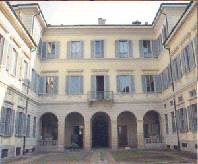
The spacious courtyard is enclosed by porticos, and is delimited on both sides by two smaller buildings that are decorated by statues and ornamental vases on the attic, as well as in the background by rusticated pillar fences carrying big ornamental vases and statues. Finally, a small, picturesque, and shady garden with old plants completes the scene.
During the period of the Cisalpine Republic (the Cisalpine Republic lasted from 1797 to 1799, then the Italian Republic from 1799 to 1805, and finally the Kingdom of Italy from 1805 to 1814) the palace was home to the French Embassy, and was owned by Count Giovanni Bovara, a professor at the University of Pavia, and Minister of Religious Affairs in the Kingdom of Italy.
The garden, which was then expanded, and it was the place for celebrations and dancing events, remained in the records of the cultured Milan of the 19th century.
In his book “I Palazzi della Vecchia Milano”, published by Ulrico Hoepli in 1945, Giacomo Bascapé outlines as part of a more general, well-chosen invention, a picturesque scene dedicated to Palazzo Bovara’s Garden. In this book Bascapé imagined himself to have fortuitously discovered in the Mellerio family’s archives, and the diary of the Count, Giacomo, one of the most prominent noblemen in Milan during the first half of the 19th century, and to have drawn from it, inspiration for a long and detailed tour to the private palaces of our city, taken by him, and by two noblewomen, the Marchioness Pallavicino of the Court of Parma and the Countess of Schonbronn (the court lady in Vienna) who came to Milan in September 1838 for the coronation of Ferdinand I.
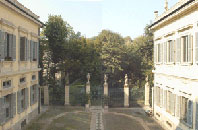
"(...) They came down again and entered the Italian garden with its beautiful walkways bordered by boxwood, neatly laid flower-beds, and small black-and-white pebble open spaces, which were in contrast with the clump of ancient oaks standing out in a corner that were probably making up what remained of the vegetable garden, and of the ancient convent’s park where the palace was built. The visitors sat down for some time to rest, and to enjoy the cool among these plants in a small clearing in what appeared to be the heart of a forest. The stone benches and wicker chairs, indeed, cutely invite to enjoy this place, made more persuasive by the suggestive environment, by bird songs and by the murmur of a brook.”
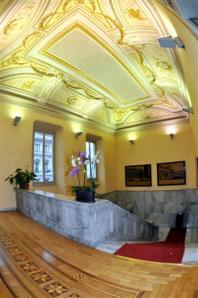
Stendhal, as a second lieutenant in the 6th Dragoons regiment, lived in this building in 1800 ("Sur le cours de cette Ponte Orientale s'est passée l'aurore de ma vie"). The building was slightly damaged during the air attacks in 1943 but it was later restored by the Architect Portaluppi. Henri Beyle from Grenoble, who is better known by his pen name Stendhal, Giacomo Bascapé wrote in his book “I Palazzi della Vecchia Milano”: “The lieutenant of the Napoleonic Army seventeen-year-old Stendhal arrived at the Palazzo Bovara in 1800 and he was so enthusiastic about the city that there was no peace in his heart until he returned here for a short period in 1811, and then finally moved here in 1813.”
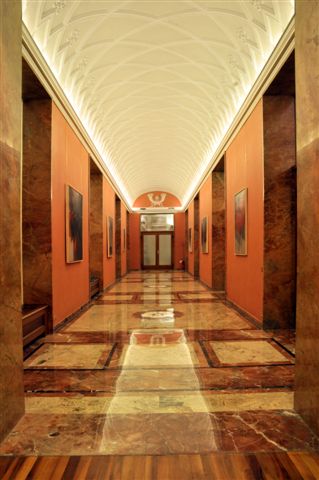 Let’s follow the palace throughout its history: It was Bovara house, that used to host the French Embassy, it then became Camozzi house and as well as the Dal Pozzo House. Later - and this is probably its most evocative name – it was called the Cuttica delle Cassine, and also Palazzo Busca. During the Fascist period the building got the name of Palazzo Benni, after the minister who bought and modified it according to the architect Della Noce’s project. The architect redid the floors (there used to be terrazzo floors and now there is an inlay wood floor coating), the galleries’ vault, the atrium and the monumental stairway. He demolished, and later rebuilt them in marble.
Let’s follow the palace throughout its history: It was Bovara house, that used to host the French Embassy, it then became Camozzi house and as well as the Dal Pozzo House. Later - and this is probably its most evocative name – it was called the Cuttica delle Cassine, and also Palazzo Busca. During the Fascist period the building got the name of Palazzo Benni, after the minister who bought and modified it according to the architect Della Noce’s project. The architect redid the floors (there used to be terrazzo floors and now there is an inlay wood floor coating), the galleries’ vault, the atrium and the monumental stairway. He demolished, and later rebuilt them in marble.
An internal elevator was also installed. On the 26th of March 1995 the Union of Trade, Tourism, Services and Professions of the Province of Milan gave back its original singularity to the second floor and inaugurated the permanent headquarters of the Circolo del Commercio. The new owner, who initially wanted to make the Palazzo Bovara, the institutional headquarters of his representative activities, is now open to the prospect of making of it one of the activists of the city culture as part of the thriving “tertiary economy” based on trade, tourism, and services.


